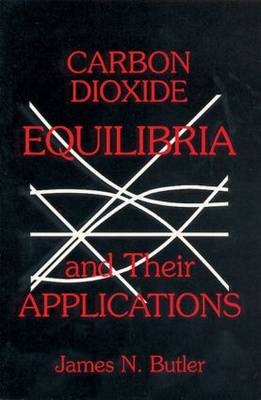
Carbon Dioxide Equilibria and Their Applications
Crc Press Inc (Verlag)
978-0-87371-624-6 (ISBN)
The book's first four chapters present the basic equations, mathematical techniques for visualizing and manipulating them, and data on equilibrium constants and activity coefficients. These are presented in the general context of acid-base titration and solubility of CaCO3. The remaining chapters show how these concepts and techniques are applied to geochemistry and oceanography, in addition to their applications to water conditioning. Specific topics discussed include acid rain, freshwater, seawater, carbonate sediments in the deep oceans, the effects of increased atmospheric CO2 on the oceans, estuarine waters, brines, hydrothermal solutions, pH adjustment, prediction of calcium carbonate saturation, corrosion inhibition, and water softening.
James N. Butler
REVIEW OF SOLUBILITY AND PH CALCULATIONS. Converting Chemical Models to Mathematical Problems. Logarithmic and Exponential Functions. A Note on Calculators. Strong Acids and Bases. Weak Acids. Titration with Strong Base. Weak Bases. Polyprotic Acids. Buffers. Solubility Product. THE BASIC EQUATIONS. Henry's Law. Hydration. Ionization. pH Dependence, Constant Partial Pressure. The Charge Balance in the Presence of Base. Alkalinity. Acidity. Solution without Gas Phase. Charge Balance and Proton Condition. Relation between Alkalinity, pH, and CT. Acidity with Constant CT. A Note on Concentration Units. Ionic-Strength Effects. The Davies Equation. Effect of Ionic Strength on KH. Effect on Ionic Strength on First Acidity Constant Ka1. Effect of Ionic Strength on Second Acidity Constant Ka2. Effect of Ionic Strength on Ion Product of Water. Effect of Ionic Strength on Solubility Product of CaCO3. THE ALKALINITY TITRATION CURVE. The Titration Curve Equation. Titration Error. Effect of Ionic Strength. Total Alkalinity and Carbonate Alkalinity. Linearized (Gran) Titration Curves. Linearizing the Acid Portion of the Alkalinity Titration. Linearizing the HCO3 Region. Other Linearized Portions of the Alkalinity Titration Curve. The CO3 Equivalence Point. Alkalinity Titration in Seawater. The Buffer Index. Buffer Index at Constant CT. Buffer Index at Constant P. SOLUBILITY EQUILIBRIA: CALCIUM CARBONATE. Calcium Carbonate, Carbon Dioxide, and Water. Dolomite. Addition of Strong Base or Strong Acid at Constant P. Limited Amount of CaCO3 in the Presence of Strong Acid. Solution without Gas Phase. Addition of Strong Acid or Base in the Presence of CaCO3 without Gas Phase. Limited Amount of CaCO3 at Constant CT. Buffer Index at Constant P with CaCO3 Present. Buffer Index at Constant CT With CaCO3 Present. Buffer Index with Constant D. APPLICATIONS TO GEOCHEMISTRY AND OCEANOGRAPHY. Rainwater. Acid Rain. River Water. Unsaturated CaCO3 as a Model for River and Groundwater. Saturated CO2, CaCO3, and H2O as a Model for River and Groundwater. Other Components of River Water. Seawater. Seawater as a Constant Ionic Strength Medium. Ion Pairing in Seawater. Total Alkalinity and Carbonate Alkalinity in Seawater. Field Observations of Seawater. The Lysocline. Effect of Increased Atmospheric CO2 on the Oceans. Fresh Waters and Estuarine Waters. Brines. Hydrothermal Solutions. ENGINEERING APPLICATIONS: WATER CONDITIONING. Estimation of Ionic Strength. pH Adjustment by Addition of Acid or Base. Addition or Removal of CO2. Addition of Lime. Addition of Limestone. The Langelier Index of CaCO3 Saturation. Corrosion Inhibition. The Lime-Soda Water Softening Process. Stoichiometric Calculations. Formulation as an Equilibrium Problem. Recarbonation. Chemical Coagulation and Flocculation. Removal of CO2 from Process Gas. APPENDIXES. SUMMARY OF IMPORTANT RESULTS. The Basic Equations. The Alkalinity Titration Curve. Solubility Equilibria: Calcium Carbonate. Applications to Geochemistry and Oceanography. Engineering Applications: Water Conditioning. USEFUL DATA TABLES. ANNOTATED BIBLIOGRAPHY. INDEX. FEATURE:
| Erscheint lt. Verlag | 7.10.1991 |
|---|---|
| Verlagsort | Bosa Roca |
| Sprache | englisch |
| Maße | 156 x 234 mm |
| Gewicht | 362 g |
| Einbandart | gebunden |
| Themenwelt | Naturwissenschaften ► Chemie ► Anorganische Chemie |
| ISBN-10 | 0-87371-624-8 / 0873716248 |
| ISBN-13 | 978-0-87371-624-6 / 9780873716246 |
| Zustand | Neuware |
| Haben Sie eine Frage zum Produkt? |
aus dem Bereich


